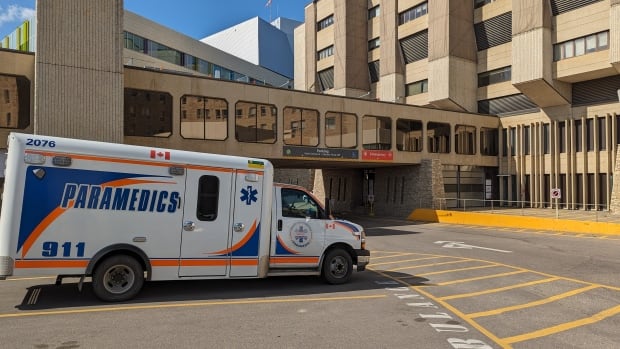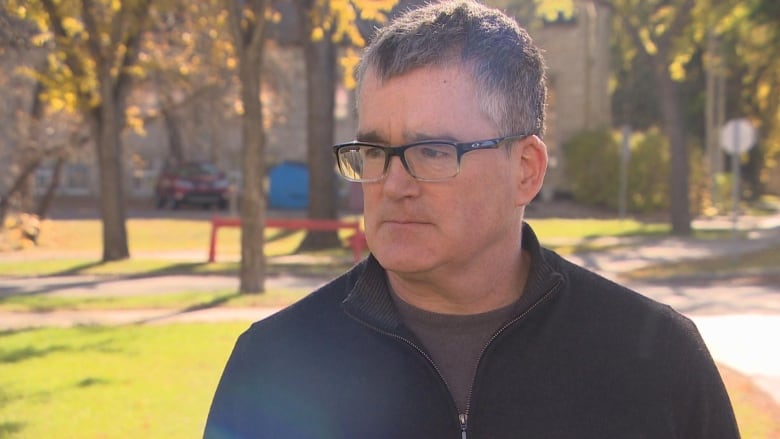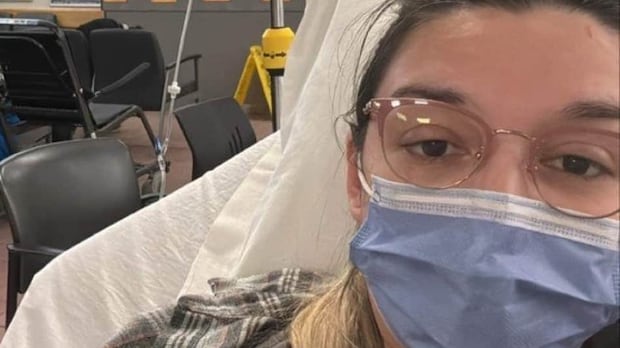
Saskatoon’s Royal University Hospital was issued a notice of contravention from a Saskatchewan Occupational Health and Safety officer stemming from overcapacity and the risks it causes to workers.
In the notice, which has been shared on social media and verified by CBC, the occupational health officer acknowledges three issues — including obstructing safe means of entry and exit areas, and obstructions that could affect staff health and welfare — all driven by too many patients in the emergency room and area.
“I’m not the least bit surprised that that happened,” said Tracy Zambory, president of the Saskatchewan Union of Nurses.
“The phenomenon that brought us to having this contravention at Royal University Hospital is not new; it has been coming and happening for what almost seems like years now.”
Following an inspection on Oct. 2, the health officer wrote there were too many patients in the area, clogging spaces that were needed to transport equipment and risking workplace injury.
It cited the emergency room manager saying there were 60 or more patients who were admitted with no beds available. The report also said the emergency room has 36 beds or chairs for patients and there were more than 90 patients in emergency.
Saskatoon and Regina both published capacity pressure action plans nearly a year ago to address issues of overcrowding.
Zambory does not believe either plan is working and blames the overcrowding on “chronic understaffing,” a lack of primary health-care providers and a lacking mental health and addictions strategy.
Shaylyn Cowper waited seven hours for a bed inside St. Paul’s emergency department. When nursing staff put her in a bed in the front entrance, she called 911 to report the fire hazard.
Dennis Kendel is a retired physician with experience in health policy. He said there are not enough beds in hospitals and pointed to that as a significant step to solving the problem.
He’s doubtful the capacity pressure action plans can work effectively without more beds.
Fixing longstanding overcapacity issues
John Ash, Saskatchewan Health Authority vice-president for integrated Saskatoon health, said there have been more than 250 staff, as well as 40 more permanent in-patient beds, added in Saskatoon, though there is still more work that needs to be done.
Ash said when there are issues of overcapacity, there are spaces that open up. As of Tuesday afternoon, there were about 40 spaces that opened up in Saskatoon hospitals, he said.
Ash said the health authority has established an incident command structure to manage capacity, including to help move people to long-term care homes more quickly or move patients back to hospitals closer to home.
According to Ash, about 30 per cent of hospital patients are from other communities outside of Saskatoon looking for a higher level of specialized care.

Overcapacity isn’t uncommon nationally, he said, and he anticipates Saskatoon will see periods of high capacity in emergency departments and its hospitals.
“That’s going to happen and I think that’s the normal kind of cycles that we’re going to see throughout, and that’s not unique to Saskatoon; it’s not unique to Saskatchewan,” Ash said.
He said the goal, through the action plan and initiatives, is to reduce the frequency and intensity of the cycles.
All three of the health and safety issues have to be remedied by Nov. 1, 2024, according to the notice.
Ash said all of the work to meet those remedies is underway.
Provincial party leaders chime in
When asked about the pressures in Saskatoon, Saskatchewan Party Leader Scott Moe pointed to the Urgent Care Centre in Regina, calling it a successful pilot project thus far, and said that model is being imitated in Saskatoon.
“I don’t know that one of those facilities in each of those communities is going to be sufficient; we likely will have to look beyond that,” he said.
Moe said that hospitals also need additional health-care workers. He said the government is committed to hiring and retaining health-care workers, which has been contested by the Saskatchewan NDP.
NDP Leader Carla Beck said the No.1 step is addressing staffing.
After that, she said, her party’s priority is to look elsewhere like reforming ambulance services, reopening the emergency room at Saskatoon City Hospital and addressing primary care issues so patients can be treated by family doctors or in their home communities.
“The solutions that I just put forward and we’ve been putting forward have been built with those who are working on the front lines,” she said.
